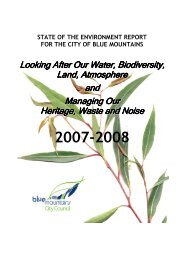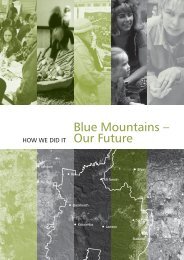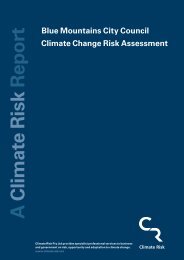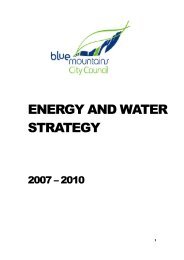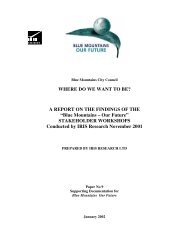State of the Environment Report for the City of Blue Mountains
State of the Environment Report for the City of Blue Mountains
State of the Environment Report for the City of Blue Mountains
You also want an ePaper? Increase the reach of your titles
YUMPU automatically turns print PDFs into web optimized ePapers that Google loves.
Section 4: Alert<br />
Climate Change<br />
Climate change and energy issues have grown significantly in importance<br />
‘People nominating climate change as one <strong>of</strong> <strong>the</strong> two most important environmental<br />
issues increased to 13% in 2006 from 6% in 2003 and 2000, and those nominating<br />
energy conservation management increased to 7% in 2006 from 2 per cent in 2003. The<br />
number <strong>of</strong> people who say <strong>the</strong>y <strong>of</strong>ten make an ef<strong>for</strong>t to reduce <strong>the</strong>ir fuel consumption<br />
and air pollution has increased by 10% since 2003 from 38 per cent to 48 per cent.’<br />
From Who Cares about <strong>the</strong> <strong>Environment</strong> in 2006 A survey <strong>of</strong> NSW people’s environmental knowledge, attitudes and behaviours.<br />
Our Land and Water<br />
Climate change will affect<br />
both <strong>the</strong> land and <strong>the</strong> water<br />
in a variety <strong>of</strong> ways that will<br />
create significant challenges<br />
<strong>for</strong> land managers.<br />
As surface temperatures rise,<br />
rainfall will increase at higher<br />
latitudes and decrease at<br />
lower latitudes. Rainfall in<br />
<strong>the</strong> Sydney Region including<br />
<strong>the</strong> <strong>Blue</strong> <strong>Mountains</strong> may fall<br />
by 20–30 per cent by 2030<br />
placing pressure on domestic<br />
water supplies (CSIRO, 2001).<br />
Shortfalls in supply will have to<br />
be made up through reuse <strong>of</strong><br />
grey water, recycling <strong>of</strong> treated<br />
sewerage and increased<br />
residential rain water capture<br />
and storage. Declining rainfall<br />
will reduce groundwater<br />
recharge and stream flow<br />
affecting natural ecosystems.<br />
Storms will increase in<br />
frequency and intensity which<br />
will place fur<strong>the</strong>r pressure on<br />
soil and streams, accelerating<br />
<strong>the</strong> process <strong>of</strong> erosion.<br />
Improvements to stormwater<br />
management will be essential<br />
in order to limit <strong>the</strong> impacts<br />
<strong>of</strong> <strong>the</strong>se changes.<br />
In <strong>the</strong> soil, a warmer<br />
environment favours <strong>the</strong><br />
growth <strong>of</strong> bacteria, which<br />
accelerates <strong>the</strong> decomposition<br />
process, hence, altering <strong>the</strong><br />
nutrient cycle. Cycling <strong>of</strong> <strong>the</strong><br />
nutrient, nitrogen, produces<br />
higher concentrations <strong>of</strong><br />
nitrous oxide, which is a<br />
greenhouse gas with a<br />
warming potential that is<br />
200–300 times more effective<br />
at trapping heat than carbon<br />
dioxide. An increase in<br />
atmospheric carbon dioxide<br />
concentration (necessary <strong>for</strong><br />
photosyn<strong>the</strong>sis) will allow<br />
more rapid plant growth.<br />
However, as temperature<br />
rises plant growth is likely to<br />
decline in response to reduced<br />
soil moisture and heat stress.<br />
Plant reproduction is typically<br />
dependant upon climatic<br />
variables. For example, apple<br />
and stone fruit bud burst<br />
is reliant upon chilling and<br />
some fruit growing areas<br />
may no longer be productive<br />
in <strong>the</strong> face <strong>of</strong> climate change.<br />
Development <strong>of</strong> new crop<br />
varieties with characteristics<br />
that will maintain productivity<br />
will be required to limit<br />
agricultural losses.<br />
The infrastructure that our<br />
society has grown reliant<br />
upon will be placed under<br />
considerable pressure as<br />
a result <strong>of</strong> climate change.<br />
Civil infrastructure built to<br />
withstand certain climatic<br />
variables will face higher<br />
and lower temperatures and<br />
more intense natural disasters,<br />
that may ultimately result<br />
in infrastructure failure or a<br />
reduced operational lifespan.<br />
Queensland investigated <strong>the</strong><br />
impact <strong>of</strong> climate change<br />
on <strong>the</strong> states’ transport<br />
infrastructure and determined<br />
that impacts will be noticeable<br />
by 2030, and without<br />
significant adaptation <strong>of</strong> <strong>the</strong><br />
transport infrastructure <strong>the</strong>re<br />
is a real risk <strong>of</strong> severe failure<br />
by 2070. Council, as with o<strong>the</strong>r<br />
regulatory authorities and<br />
infrastructure managers,<br />
will need to adopt improved<br />
construction practices taking<br />
into account <strong>the</strong> potential <strong>for</strong><br />
climate change and will need<br />
to address issues in <strong>the</strong> existing<br />
infrastructure.<br />
Our Natural<br />
<strong>Environment</strong><br />
Many <strong>of</strong> Australia’s natural<br />
systems will be vulnerable to<br />
<strong>the</strong> effects <strong>of</strong> climate change<br />
due to <strong>the</strong> limited adaptive<br />
capability. Those ecosystems<br />
or species with specialised<br />
ecological requirements,<br />
limited distribution or mobility,<br />
will be most at risk. Climate<br />
induced changes affecting<br />
biota include: a change in<br />
rainfall distribution, intensity<br />
and seasonality, altered growth<br />
patterns associated with<br />
increased carbon dioxide,<br />
increased temperature<br />
affecting growth and heat<br />
stress and change in sea level<br />
affecting marine, aquatic and<br />
riparian ecosystems. Extreme<br />
events such as drought, flood,<br />
cyclones, and wildfire will<br />
increase causing fur<strong>the</strong>r<br />
impacts. Already <strong>the</strong>re has<br />
been observed changes in<br />
Australian biota as a result <strong>of</strong><br />
global warming. These include<br />
early breeding in birds and<br />
reptiles, earlier flowering <strong>of</strong><br />
eucalypts and early arrival <strong>of</strong><br />
migratory birds.<br />
2005–2006 Supplementary <strong>State</strong> <strong>of</strong> <strong>the</strong> <strong>Environment</strong> <strong>Report</strong> <strong>for</strong> <strong>the</strong> <strong>City</strong> <strong>of</strong> <strong>Blue</strong> <strong>Mountains</strong> 33



